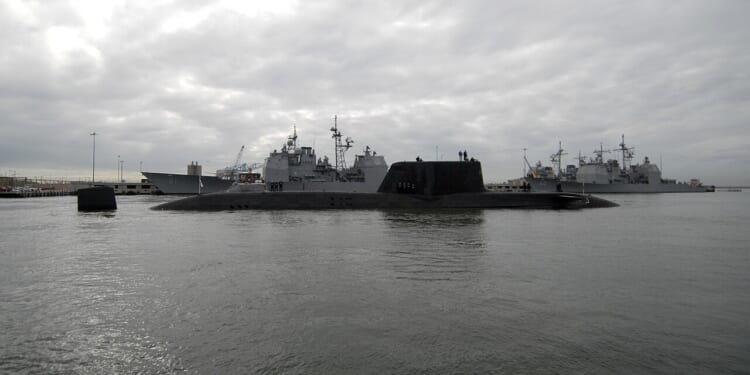Many Royal Navy ships throughout history have been named after figures and creatures from ancient Greek mythology. The current vessel is the sixth to bear the name “Agamemnon.”
King Charles III, the King of the United Kingdom, visited the Royal Port of Barrow on Monday for the commissioning ceremony of HMS Agamemnon, the sixth of seven planned Astute-class nuclear-powered fast attack submarines. The boat, which was built at BAE Systems’ facilities in Barrow, is also the sixth Royal Navy vessel to be named for the legendary ancient Greek king Agamemnon of Mycenae.
It is the first time King Charles III has visited Barrow-in-Furness, England, since the port was granted the title of “Royal” this past March, in recognition of the town’s contribution to British national security. Also on Monday, the port facility cut the first steel for HMS King George VI, the fourth and final Dreadnought-class submarine. That boat is named for Charles III’s grandfather, who led the UK through World War II.
“The commissioning of HMS Agamemnon and the steel cut for HMS King George VI mark significant milestones in the Royal Navy’s enduring commitment to safeguarding our nation,” said First Sea Lord Sir Gwyn Jenkins. “These achievements underscore the critical role of the Continuous at Sea Deterrent and the importance of cutting-edge warfighting capabilities in an ever-evolving threat landscape.”
The Boat Already Has a Nickname: “Awesome Aggie”
HMS Agamemnon is expected to complete her sea trials and is now on track to enter operational service by late next year or early 2027. The boat has already been nicknamed the “Awesome Aggie.”
“Agamemnon is a name which carries a long, distinguished history of naval service from Trafalgar to Crimea to the Great War,” said Defence Secretary John Healey, who joined King Charles III during Monday’s ceremonies. “Agamemnon has been in the front line, an enduring symbol of British strength and victory. As the crew of this boat, you now send that proud tradition into the future.”
Five previous Royal Navy warships have been named HMS Agamemnon after the legendary Greek warrior king who commanded the Achaeans during the Trojan War. That has included the 64-gun third-rate ship-of-the-line that participated in the Battle of Trafalgar in 1805, as well as the Lord Nelson-class pre-dreadnought battleship that saw service in the Dardanelles Campaign of the First World War.
Many Royal Navy ships throughout history have been named after figures and creatures from ancient Greek mythology.
“The Royal Navy has always respected the figures of the Trojan War, possibly because, for the Greeks, it was a seaborne war: or perhaps because of the exaggerated respect that the mostly unlettered British naval officers of the 18th and 19th centuries had for classical learning,” Lewis Page, a former Royal Navy officer, previously explained for The Telegraph.
Page added that a previous HMS Agamemnon had been present at such worthy sea battles as Copenhagen and Trafalgar, and later took part in the ill-fated Dardanelles campaign of World War I and the mine warfare campaigns of World War II.
“In a historical echo reverberating particularly loudly today, an HMS Agamemnon was there when Britain fought Russia in the Crimea,” Page continued. “When the ship’s company of the latest Agamemnon raise their glasses to the Immortal Memory of Lord Nelson on Trafalgar Night, they will no doubt recall with pride that Admiral Nelson had been captain of the first HMS Agamemnon.”
About the UK’s Astute-Class Submarines
The Royal Navy’s Astute-class boats were the first nuclear-powered submarines in the world to be designed in a 3D computer-aided environment. Each has been outfitted with numerous technological firsts, including the absence of an optical periscope. Instead, high-specification video technology has been employed, which enables the crew to scan the horizon and get a 360-degree view to address any potential threat.
In addition, unlike other nuclear-powered submarines, the Astute-class was developed to utilize state-of-the-art anti-acoustic tiles. Each hull is fitted with more than 39,000 acoustic tiles that mask the vessel’s sonar signature and allow the submarines to glide through the water almost silently. The slight noise the boats give off has actually been compared to that of a “baby dolphin.”
The nuclear-powered attack submarines were designed to protect the Royal Navy’s nuclear deterrent boats, the Queen Elizabeth-class aircraft carriers and strike groups, as well as critical undersea infrastructure around the British Isles. The attack submarines also have stowage for 38 weapons and typically carry a mix of Spearfish heavy torpedoes and Tomahawk Block IV cruise missiles, which are capable of hitting a target to within a few meters, with a range of up to 1,000 miles (1,600 km). The submarines’ countermeasures suite includes decoys and electronic support measures (ESM).
The boats are also fitted with a dry deck shelter, which allows Special Forces – such as the Royal Marine Commandos or Royal Navy Special Boat Service (SBS) operators to deploy whilst the submarine is submerged.
About the Author: Peter Suciu
Peter Suciu has contributed over 3,200 published pieces to more than four dozen magazines and websites over a 30-year career in journalism. He regularly writes about military hardware, firearms history, cybersecurity, politics, and international affairs. Peter is also a contributing writer for Forbes and Clearance Jobs. He is based in Michigan. You can follow him on Twitter: @PeterSuciu. You can email the author: [email protected].
Image: Wikimedia Commons.


















